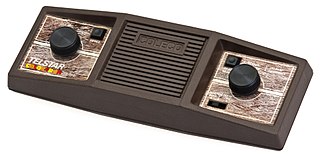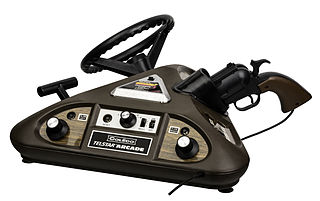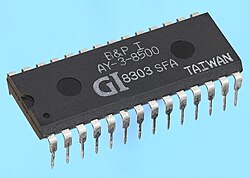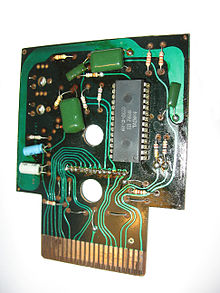
The Atari 2600 is a home video game console developed and produced by Atari, Inc. Released in September 1977, it popularized microprocessor-based hardware and games stored on swappable ROM cartridges, a format first used with the Fairchild Channel F in 1976. Branded as the Atari Video Computer System from its release until November 1982, the VCS was bundled with two joystick controllers, a conjoined pair of paddle controllers, and a game cartridge—initially Combat and later Pac-Man.

The ColecoTelstar brand is a series of dedicated first-generation home video game consoles produced, released and marketed by Coleco from 1976 to 1978. Starting with Coleco Telstar Pong clone based video game console on General Instrument's AY-3-8500 chip in 1976, there were 14 consoles released in the Coleco Telstar series. About one million units of the first model called Coleco Telstar were sold.

The Magnavox Odyssey 2, also known as Philips Odyssey 2, is a second generation home video game console that was released in 1978. It was sold in Europe as the Philips Videopac G7000, in Brazil and Peru as the Philips Odyssey and in Japan as Odyssey2. The Odyssey 2 was one of the five major home consoles prior to the 1983 video game market crash, along with Atari 2600, Atari 5200, Intellivision and ColecoVision.

Pong is a table tennis–themed twitch arcade sports video game, featuring simple two-dimensional graphics, manufactured by Atari and originally released in 1972. It was one of the earliest arcade video games; it was created by Allan Alcorn as a training exercise assigned to him by Atari co-founder Nolan Bushnell, but Bushnell and Atari co-founder Ted Dabney were surprised by the quality of Alcorn's work and decided to manufacture the game. Bushnell based the game's concept on an electronic ping-pong game included in the Magnavox Odyssey, the first home video game console. In response, Magnavox later sued Atari for patent infringement.

The Magnavox Odyssey is the first commercial home video game console. The hardware was designed by a small team led by Ralph H. Baer at Sanders Associates, while Magnavox completed development and released it in the United States in September 1972 and overseas the following year. The Odyssey consists of a white, black, and brown box that connects to a television set, and two rectangular controllers attached by wires. It is capable of displaying three square dots and one line of varying height on the screen in monochrome black and white, with differing behavior for the dots depending on the game played. Players place plastic overlays on the screen to display additional visual elements for each game, and one or two players for each game control their dots with the knobs and buttons on the controller by the rules given for the game. The console cannot generate audio or track scores. The Odyssey console came packaged with dice, paper money, and other board game paraphernalia to accompany the games, while a peripheral controller—the first video game light gun—was sold separately.
A dedicated console is a video game console that is limited to one or more built-in video game or games, and is not equipped for additional games that are distributed via ROM cartridges, discs, downloads or other digital media. Dedicated consoles were very popular in the first generation of video game consoles until they were gradually replaced by second-generation video game consoles that use ROM cartridges.

The ColecoTelstar Marksman, commonly abbreviated as Telstar Marksman, is a first-generation home video game console that featured a light gun. It was released by Coleco in 1978. Because it had a manufacturer-set number of games, it is considered a dedicated console. It was part of the Coleco Telstar series Pong-based home video game consoles; it is essentially a Coleco Telstar Colortron bundled with a "3 in 1" light gun and two shooting games. The Marksman light gun is a pistol that features an attachable stock and barrel. It is similar in this regard to the later-released Stack Light Rifle and the Sega Menacer. The elongated barrel included a simple aiming sight. In addition to the light gun, the system featured two paddle controllers built directly into the console. Its reported features included "on-screen digital scoring" and three different difficulty settings. It required two nine-volt batteries or Coleco's Perma Power AC adaptor to power the system.

In the history of video games, the first generation era refers to the video games, video game consoles, and handheld video game consoles available from 1972 to 1983. Notable consoles of the first generation include the Odyssey series, the Atari Home Pong, the Coleco Telstar series and the Color TV-Game series. The generation ended with the Computer TV-Game in 1980 and its following discontinuation in 1983, but many manufacturers had left the market prior due to the market decline in the year of 1977 and the start of the second generation of video game consoles.
The TV Scoreboard is a Pong-like dedicated home video game console manufactured in Hong Kong from 1976 through the early '80s and made by Tandy. Distribution was handled exclusively by RadioShack.
Unisonic Products Corporation was an American manufacturer and distributor of consumer electronics from the 1970s to the 1990s. Although headquartered in New York City, Unisonic outsourced its manufacturing operations to various facilities in East Asia. Unisonic developed a variety of electronics, including calculators, CRT television sets, video game consoles, digital watches, telephones, answering machines, and digital alarm clocks.
Magnavox Odyssey is the general brand name of Magnavox's complete line of home video game consoles released from 1972 through 1978. The line includes the original Magnavox Odyssey console, the Magnavox Odyssey series of dedicated home video game consoles, and the Magnavox Odyssey 2 ROM cartridge-based video game console released in 1978. Philips Odyssey is the brand name that includes the Philips Odyssey series of dedicated home video game consoles.

The 1970s was the first decade in the history of the video game industry. The 1970s saw the development of some of the earliest video games, chiefly in the arcade game industry, but also several for the earliest video game consoles and personal computers.

The Ping-O-Tronic is a dedicated first-generation home video game console produced by Zanussi, an Italian home appliance company, and released under their Sèleco brand in late-1974 only in Italy. It was the first Italian video game console, excluding Magnavox Odyssey imports and clones.
The Philips Tele-Game series was a series of six dedicated first-generation home video game consoles manufactured, released and marketed between 1975 and 1978 by Dutch company Philips.

The PC-50x Family is a series of home video game consoles belonging to the first generation prevalent in Europe between 1977 and the early 1980s, all produced in Asia. The designation PC-50x of the series derives from the name of the cartridges.

The Coleco Telstar Arcade, commonly abbreviated as Telstar Arcade, is a first-generation home video game console that was released in 1977 in Japan, North America and Europe by Coleco. It is the most advanced video game console in the Coleco Telstar series, based on the MOS Technology MPS-7600-00x chips series. Each chip is a microcontroller capable of storing 512 words of ROM.

The Interton Video 2400 is a dedicated first-generation home video game console that was released in 1975 by Interton. It is the successor of the Interton Video 2000 and the predecessor of the Interton Video 2501. It could output only black and white. The console uses the AY-3-8500 chipset. The sound is played through an internal speaker, rather than the TV set.

The Wonder Wizard is a dedicated first-generation home video game console which was manufactured by Magnavox and released by General Home Products in June 1976 only in the United States.

In the video game industry, the market for home video game consoles has frequently been segmented into generations, grouping consoles that are considered to have shared in a competitive marketspace. Since the first home consoles in 1972, there have been nine defined home console generations.
























